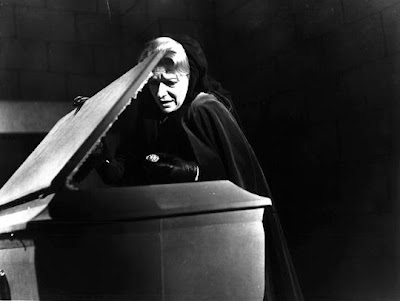Writer / Producer / Director: Del Tenney
Music: Bill Holcomb
Cinematography: Richard Hilliard
Iselin-Tenney Productions; 83 min; B&W
Cast:
Helen Warren (Abigail Sinclair), Roy Scheider (Philip Sinclair), Margot Hartman (Vivian Sinclair), Robert Mill (Bruce Sinclair), Hugh Franklin (James Benson), Linda Donovan (Letty Crews), Dino Narizzano (Robert Harrington), Candace Hilligoss (Deborah Benson), J. Frank Lucas (Seth Lucas)
One of the greatest double-bills in drive-in history is the pairing of two horror films by Connecticut-based auteur Del Tenney: Horror of Party Beach and Curse of the Living Corpse. Although independently produced, these movies were picked up as a double bill for distribution by Twentieth Century Fox for a successful run in drive-ins. Horror of Party Beach is the most famous of the two; a goofy outing about radioactive monsters terrorizing a seaside community. Both films are well-produced despite their meagre budgets and nicely shot by Richard Hillard: each fine examples of regional filmmaking, that transcend the accepted truth of such movies' poor quality.
This motley bunch must fulfill his demands for the following year or lose the inheritance (assuming they stay alive during that time). Part of the fun in the movie is pondering whether any of these people are at all deserving of any fortune. Sinclair's son Philip is a drunken sot who is glad to be rid of his tyrannical father, while his other son Bruce is a vain cad who romances Philip's wife and one of the servants! Meanwhile, Sinclair's widow wants to brick up the house out of her fear of fire! Since the wishes of the deceased had already been abused even before the reading of the will, it isn't long before a masked killer (resembling The Shadow out of pulp magazines) starts killing them off in fashions correlating to their individual phobias.
Horror of Party Beach is the better known film of this double bill, thanks to incessant TV airings, much coveted rock soundtrack and even the release of a photo comic book. Its sister movie mostly gets mentioned as the debut of actor Roy Scheider (here with the middle initial "R." in the credits) - he is quite good as the souse Philip. This role is a rare time for him to play melodrama verging on comedy. It is also remembered for a supporting role by Carnival of Souls beauty Candace Hilligoss, who could have been a major scream queen in the 1960s; alas, this was her final horror picture. Despite that Party Beach has more appeal and longevity, I would argue that Curse of the Living Corpse is the superior of the two films, as it is a lean, fast-moving, surprisingly well-made little movie.
 |
| ABOVE: Candace Hilligoss |
 |
| ABOVE: Roy R. Scheider |
It has been suggested by some that the artistic success of Del Tenney's flims is due to his cameraman Richard Hilliard, although I think that is only partially true. This Gothic piece, set in 1892, benefits greatly from his crisp, moody black-and-white photography. There is also inventive framing (love the opening overhead shot where Sinclair is being put into the hearse- purposefully obscuring his looks so that we can't identify the killer later on), good staging and use of foregrounds. Richard Hilliard has also worked as a director, but I've only seen The Lonely Sex from that short list, and I'm not sure if that miserable film is something to assess his directorial talent with.
Curse of the Living Corpse loses its way a bit with the addition of two inspectors in the finale; their comic relief isn't nearly as biting as the sardonic material that precedes it. This glorious-looking, unabashedly nasty little melodrama is also a sinfully entertaining black comedy about some loathsome people who receive some retribution.







No comments:
Post a Comment